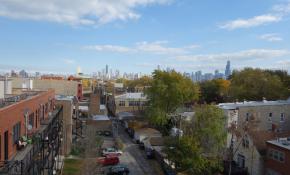On a good day many journalists will say we’re writing the first draft of history. But that lofty ideal often gets shredded by the grind of deadlines and existential angst about the very future of news.
But every now and then, we get a glimpse of how truly transformative even seemingly small acts of journalism can be — the ways in which every story we put out in the world takes on a whole life of its own.
I got a taste of that with a documentary I produced called "The Feminist on Cellblock Y." The documentary, now available to stream on CNNgo, follows a group of convicted felons as they wrestle with toxic masculinity as a means of rehabilitation.
It took about 18 months to report. We shot over the span of several months and juggled the logistics required for filming in a prison, including a brief lockdown.
But the story got its true start a decade ago in an improbable way: with a Valentine’s Day issue of Le Sabre, a high school newspaper in the San Fernando Valley outside Los Angeles put out by its teenage editor, Richard Edmond.
Coleen Bondy was the supervisor of the paper at the time, and she’s never forgotten Richie, as he was called. “He was unusual,” she told me, “in a good way. Mature, very intelligent, very committed to his beliefs, but he had a real problem with authority.”
For Valentine’s Day, Richie had an idea that would challenge all kinds of authorities. He wanted to tackle sexual objectification of women and shame around female sexuality. So he printed a diagram of the female anatomy, right on the cover. It made sense, in a teenage kind of way. Bondy didn’t want to censor her students, and she felt like the publishing didn’t violate any kind of law, so she let them go ahead.
School administrators felt differently and confiscated all the papers.
Over at The Los Angeles Times, Susannah Rosenblatt heard about the ensuing uproar and talked to Richie about it. From her story:
“Edmond said administrators did not explain to his satisfaction why this copy of Le Sabre was unfit for distribution. He said he was told by administrators: ‘This is not in the taste of the school; this is a high school, not Hollywood Boulevard.’ ‘As far as I was concerned,’ Edmond said, ‘they were wrongfully taking our papers away.’”
Across the country, I was practicing some student journalism of my own. As news director of WRAS, Georgia State’s radio station, I got an hour a week to broadcast interviews of any topic I wanted. It was nirvana for a journalist. And so, every day I’d scour for stories, talking to local academics, politicians and activists, as well as reading local papers for ideas. Included in my daily digest was The Los Angeles Times.
I contacted Richie on Facebook, asked him for an interview and over the span of about a half hour, we talked about the paper and his fight for female equality. The interview aired on "The Hub" to Album 88’s legion fans who gamely tolerated the news break in their otherwise brilliantly curated musical offerings. I thanked him for his time and later sent him a CD copy of his interview, I was 23, he was 15.
Years later, I saw that he’d been arrested for something but I didn’t pay much attention.
But that’s the thing about stories, they sometimes take a twist.
In the winter of 2016, I was working on a master of fine arts at the University of Georgia and working at CNN. I’d been trying to find people to interview within the criminal justice system for a series about the myriad changes occurring there.
I remembered that high school editor and wondered what happened to him. I messaged him on Facebook, and his wife replied (he’d gotten married in the intervening years). She told me Richie was in prison and advised me how to set up a phone account.
Now, about eight years after our first interview, he called and I started interviewing him again.
After the Valentine’s Day issue, Richie had dropped out of school. He got a job, he lost that job and he committed two armed robberies for which a judge gave him 10 years. But I discovered that he was still on a feminist soapbox, even in prison.
Even more improbably, he’d found some men inside who agreed with him and met weekly to challenge toxic masculinity. I discovered that their project could earn them time off their sentence as California struggled with ways to reduce its swollen prison population.
It was a good story, and I lucked out with an amazing team to tell it.
Last summer, Contessa Gayles, a brilliant photojournalist at CNN, and Eric Day a talented freelance sound guy, and I hopped a plane and rolled up to the white-washed three-story prison that is the Correctional Training Facility in Soledad. We returned over the course of several weeks, capturing the men having the most revealing and powerful conversations, scenes captured in our documentary.
When the project was nearly complete, I started wondering about Susannah Rosenblatt, the woman whose article set me off down this path. So I found her on Twitter. She’s no longer at The Los Angeles Times, but I thought she she’d appreciate the life her article still had and how many people it impacted.
“The Rosenblatt byline lives!” she tweeted, adding several of her colleagues.
I smiled as their Twitter reunion flashed across my screen.
That’s the thing about journalism; we tell stories and along the way those seeds grow, the first draft of history sometimes blossoming into the kinds of gardens we could never have even imagined.








